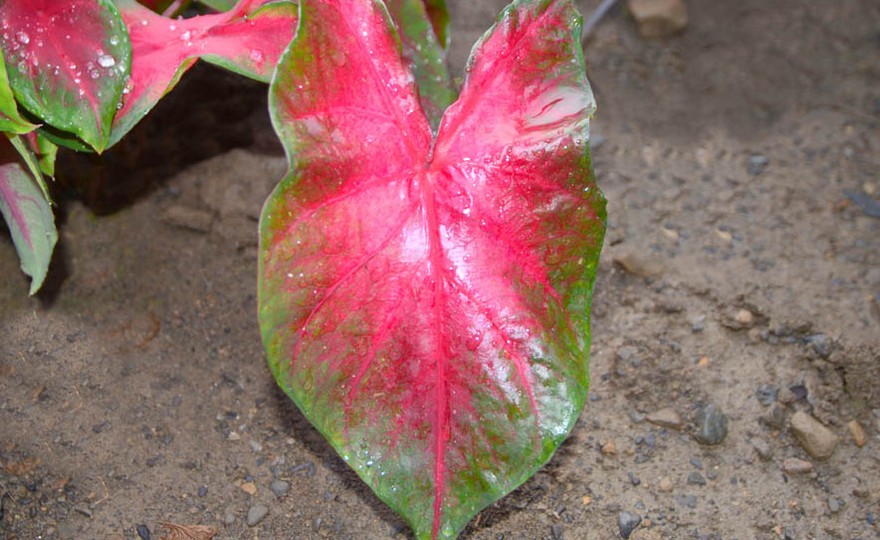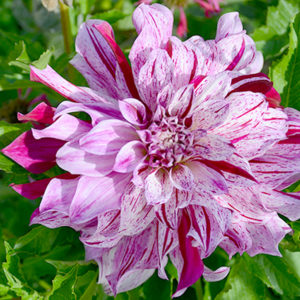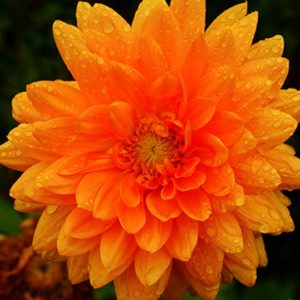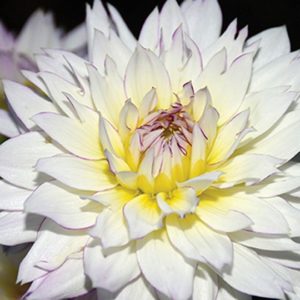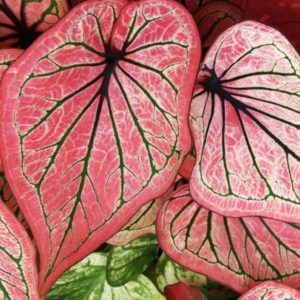Description
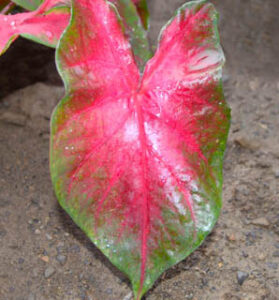 Caladium,
Caladium,
Red Flash
Of all the plants that you can introduce into your shade or partial shade garden, caladiums and coleus offer the most brilliant color and color variations. In Zones 8-11 caladiums can be left in the ground year round. They will go into dormancy and their leaves will die back in the fall, but shortly after Christmas, the plants will re-emerge from the soil. In Zones 4-7, the roots need to be lifted before the first frost and stored in a cool, dry place which has good air circulation. Caladiums produce a nondescript flower engulfed in an equally nondescript spathe. You grow these plants for their remarkable leaves, not their blossoms. However, their leaves are as dramatic as any flower in the garden.
Caladiums were discovered in South America by the Spanish explorers in the 1500s. Most of the known species are native to parts of Brazil. A few species are native to Peru and the West Indies. The plants were introduced into Europe but because of their fragile tropical nature did not thrive. With the introduction of greenhouses and conservatories available to the upper and middle classes in the latter part of the19th century, caladiums rose in popularity. The plants, with their stunning leaves, were easy to grow and real ‘show stoppers’ in the conservatories of the day.
The name, Caladium, comes from the South American Indian term ‘kelady’ meaning unknown. The rhizomes of the Kelady were roasted or boiled by the Indians and eaten. In the West Indies, the leaves of the Kelady were boiled and eaten as a vegetable.
Most of the caladiums available today are cultivars of C. bicolor. This caladium is native to Brazil, Trinidad and Guyana. It was brought to Europe and the British Isles in 1864. Today there is a classification of caladiums known as “Fancy Leaf” caladiums. These cultivars were developed from the C. bicolor subspecies C. picturatum or C. bicolor. Botanically they are classified as C. hortulanum. The C. picturatum have narrow leaves and the hybrids developed from C. bicolor have heart-shaped leaves. The ability of C. bicolor to sport cultivars in a vast number of color combinations and leaf textures and shapes is the reason that this plant has been used in the widespread development of new caladium cultivars.
In the US, 98% of all Caladiums come from Lake Placid, Florida affectionately known as The Caladium Capital of the World. The tiny town is surrounded by hundreds of acres of Caladium farms, and the town, itself, is decorated with 40 murals many of them depicting Caladiums. The town was chartered in 1925 as Lake Stearns, but at the request of Dr. Melvil Dewey, inventor of the Dewey Decimal System, the name was changed to Lake Placid in 1927. In late July, each year, the town holds a Caladium Festival where farms display an assortment of their Caladiums.
Caladiums grow from tuberous roots which are hardy in Zones 8 and higher. In Hardiness Zones 4-6, start roots indoors in April and transplant outside when the nighttime temperatures reach 55 degrees. In Hardiness Zones 7 and higher, roots can be started outside when the danger of frost has passed and the soil has warmed. Plant the roots in organically rich soil amended with bone meal. Keep the soil moist, but do not allow the roots to stand in water. In Zones 4-7, the roots need to be lifted when the nighttime temperatures fall below 55 degrees. Roots should be stored in a cool, dry, dark area. In Zones 8 and higher, roots can be left in the ground after the plant dies back, if heavily mulched.
Caladiums thrive in containers – 1-2 roots per 8 in. diameter pot. For the showiest results, plant 3 roots in a 10-12 inch pot.
The best soil mix is 40% topsoil, 40% peat moss and 20% compost or dehydrated cow manure. Check out the soil mix described in detail in our Harvesting History YouTube video. Do not use prepared soil mixes.
The Best Soil Mix for Containers
The tubers should be planted 2-4 inches deep and thrive when fertilized once a month with a complete fertilizer like 10-10-10. Constantly moist soil is a requirement. Once the plants have ceased flowering in the fall, they can be stored in their pots or their roots lifted. Store roots and/or pots in a cool, dry, dark area.

